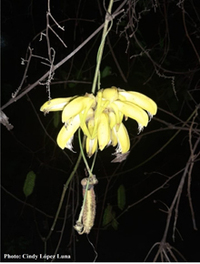Pollinator dependency determines the susceptibility to habitat fragmentation of Mucuna mutisiana (Kunth) D.C. Fabaceae in the Tropical Dry Forest of the Colombian Caribbean
Abstract
Plant responses to habitat fragmentation are determined by their reproductive system and the level of specialization in their pollination system. One way to understand possible responses is through reproductive success, degree of self-compatibility, and susceptibility to pollination. Mucuna mutisiana, a liana typical of secondary forests and associated with the banks of rivers in the Tropical Dry Forests (BsT) of the Colombian Caribbean, flowers throughout the year, although it is more frequent in the rainy season, most visits to Its flowers are caused by nectarivores bats, mainly Glossophaga soricina and Glossophaga longirostris. We describe that the specialization of pollination increases this susceptibility to fragmentation due to the negative effect it has on the reproductive success of plants by limiting the quantity or quality of the pollen they receive. Using controlled pollination methods, the reproductive susceptibility to pollen limitation was evaluated through the reproductive success of Mucuna mutisiana. We performed a consistent artificial pollination factorial experiment with different levels of pollen limitation that allowed us to estimate the production of fruits and seeds. We report that M. mutisiana is partially self-compatible, with an ISI = 0.776 and reproductive success of 34.04% when visited by its effective pollinators. An analysis of variance showed that there is differentiation in fruit production between the different levels of controlled pollination, being higher in natural pollination and pollination with own pollen, unlike cross pollination where the results were not significant. In addition, no differences were found between seed production by natural pollination and by self-pollination, with a higher seed production being observed in cross-pollination. This confirms that M. mutisiana has an affinity for its own pollen depending on its pollinators, it is evident that they are facultative xenogamous with mixed mating, which gives them reproductive security with advantages for the fitness of their populations. This is a particularly clear focus for developing native habitat restoration and conservation strategies.
Downloads
References
Agostini, K. 2004. Ecologia da polinização de Mucuna sp. Nov. (Fabaceae) no Litoral Norte de São Paulo, Brasil. 97fl. Dissertação (mestrado) - Universidade Estadual de Campinas, Instituto de Biologia, Campinas, SP.
Aguilar, R., Ashworth, L., Galetto, L. y Aizen, M.A. 2006. Plant reproductive susceptibility to habitat fragmentation: review and synthesis through a meta-analysis. Ecology Letters, 9, 968–980. https://doi.org/10.1111/j.1461-0248.2006.00927.x
Aguilar, R., Cristóbal‐Pérez, E.J., Balvino‐Olvera, F.J., Aguilar‐Aguilar, M., Aguirre‐Acosta, N., Ashworth, L., Lobo, J.A., Martén‐Rodríguez, S., Fuchs, E.J., Sanchez‐Montoya, G., Bernardello, G. y Quesada, M. 2019. Habitat fragmentation reduces plant progeny quality: a global synthesis. Ecology Letters, 22, 1163–1173. https://doi.org/10.1111/ele.13272
Aizen, M.A., Ashworth, L. y Galetto, L. 2002. Reproductive success in fragmented habitats: do compatibility systems and pollination specialization matter? Journal of Vegetation Science, 13: 885-892. https://doi.org/10.1111/j.1654-1103.2002.tb02118.x
Aizen, M.A. y Feinsinger, P. 1994. Forest Fragmentation, Pollination, and Plant Reproduction in a Chaco Dry Forest, Argentina. Ecology, 75, 330–351. https://doi.org/10.2307/1939538
Ashman, T.-L., Knight, T.M., Steets, J.A., Amarasekare, P., Burd, M., Campbell, D.R., Dudash, M.R., Johnston, M.O., Mazer, S.J., Mitchell, R.J., Morgan, M.T. y Wilson, W.G. 2004. Pollen limitation of plant reproduction: Ecological and evolutionary causes and consequences. Ecology, 85, 2408–2421. https://doi.org/10.1890/03-8024
Barros, E.C. de O., Webber, A.C. y Machado, I.C. 2013. Limitação de polinizadores e mecanismo de autoincompatibilidade de ação tardia como causas da baixa formação de frutos em duas espécies simpátricas de Inga (Fabaceae - Mimosoideae) na Amazônia Central. Rodriguésia, 64, 37–47. https://doi.org/10.1590/S2175-78602013000100005
Bawa, K.S. 1974. Breeding systems of tree species of a lowland tropical community. Evolution, 28, 85–92. https://doi.org/10.1111/j.1558-5646.1974.tb00729.x
Bennett, J.M., Steets, J.A., Burns, J.H., Durka, W., Vamosi, J.C., Arceo-Gómez, G., Burd, M., Burkle, L.A., Ellis, A.G., Freitas, L., Li, J., Rodger, J.G., Wolowski, M., Xia, J., Ashman, T.-L. y Knight, T.M. 2018. GloPL, a global data base on pollen limitation of plant reproduction. Scientific Data, 5, 180249. https://doi.org/10.1038/sdata.2018.249
Breed, M.F., Gardner, M.G., Ottewell, K.M., Navarro, C.M. y Lowe, A.J. 2012. Shifts in reproductive assurance strategies and inbreeding costs associated with habitat fragmentation in Central American mahogany: Reproductive assurance shifts in mahogany. Ecology Letters, 15, 444–452. https://doi.org/10.1111/j.1461-0248.2012.01752.x
Brito, V.L.G. de, Pinheiro, M. y Sazima, M. 2010. Sophora tomentosa e Crotalaria vitellina (Fabaceae): biologia reprodutiva e interações com abelhas na restinga de Ubatuba, São Paulo. Biota Neotropica, 10, 185–192. https://doi.org/10.1590/S1676-06032010000100019
Cruden, R.W. (1979) Pollen-Ovule Ratios: A Conservative Indicator of Breeding Systems in Flowering Plants. Evolution. 1977 Mar;31(1):32-46. https://doi.org/10.1111/j.1558-5646.1977.tb00979.x PMID: 28567723
Dainese, M., Martin, E.A., Aizen, M.A., Albrecht, M., Bartomeus, I., Bommarco, R., Carvalheiro, L.G., Chaplin-Kramer, R., Gagic, V., Garibaldi, L.A., Ghazoul, J., Grab, H., Jonsson, M., Karp, D.S., Kennedy, C.M., Kleijn, D., Kremen, C., Landis, D.A., Letourneau, D.K., Marini, L., Poveda, K., Rader, R., Smith, H.G., Tscharntke, T., Andersson, G.K.S., Badenhausser, I., Baensch, S., Bezerra, A.D.M., Caballero-Lopez, B., Cavigliasso, P., Classen, A., Cusser, S., Dudenhöffer, J.H., Ekroos, J., Fijen, T., Franck, P., Freitas, B.M., Garratt, M.P.D., Gratton, C., Hipólito, J., Holzschuh, A., Hunt, L., Iverson, A.L., Jha, S., Keasar, T., Kim, T.N., Kishinevsky, M., Klatt, B.K., Klein, A.-M., Krewenka, K.M., Krishnan, S., Larsen, A.E., Lavigne, C., Liere, H., Maas, B., Mallinger, R.E., Pachon, E.M., Martínez-Salinas, A., Meehan, T.D., Mitchell, M.G.E., Molina, G.A.R., Nesper, M., Nilsson, L., O’Rourke, M.E., Peters, M.K., Ple, M., Ramos, D. de L., Rosenheim, J.A., Rundlöf, M., Rusch, A., Sáez, A., Scheper, J., Schleuning, M., Schmack, J.M., Sciligo, A.R., Seymour, C., Stanley, D.A., Stewart, R., Stout, J.C., Sutter, L., Takada, M.B., Taki, H., Tamburini, G., Tschumi, M., Viana, B.F., Westphal, C., Willcox, B.K., Wratten, S.D., Yoshioka, A., Zaragoza-Trello, C., Zhang, W., Zou, Y. y Steffan-Dewenter, I. 2019. A global synthesis reveals biodiversity-mediated benefits for crop production. Sci Adv. 2019 Oct 16;5(10): eaax0121. https://doi.org/10.1126/sciadv.aax0121 PMID: 31663019; PMCID: PMC6795509.
Dicenta, F., Ortega, E., Canovas, J.A. y Egea, J. 2002. Self-pollination vs. cross-pollination in almond: pollen tube growth, fruit set and fruit characteristics. Plant Breeding, 121, 163–167. https://doi.org/10.1046/j.1439-0523.2002.00689.x
Diego, C.E.N., Stewart, A.B. y Bumrungsri, S. 2019. Pollinators Increase Reproductive Success of a Self-Compatible Mangrove, Sonneratia ovata, in Southern Thailand. Tropical Nature History. https://li01.tci-thaijo.org/index.php/tnh/article/view/207689
Eckert, C.G., Kalisz, S., Geber, M.A., Sargent, R., Elle, E., Cheptou, P.-O., Goodwillie, C., Johnston, M.O., Kelly, J.K., Moeller, D.A., Porcher, E., Ree, R.H., Vallejo-Marín, M. y Winn, A.A. 2010. Plant mating systems in a changing world. Trends in Ecology & Evolution, 25, 35–43. https://doi.org/10.1016/j.tree.2009.06.013
Etcheverry, A.V., Alemán, M.M., Figueroa-Fleming, T., López-Spahr, D., Gómez, C.A., Yáñez, C., Figueroa-Castro, D.M. y Ortega-Baes, P. 2011. Pollen:ovule ratio and its relationship with other floral traits in Papilionoideae (Leguminosae): an evaluation with Argentine species. Plant Biology, 14: 171-178. https://doi-org.ezproxy.uninorte.edu.co/10.1111/j.1438-8677.2011.00489.x
Faegri, K. & Pijl, L. van der. 1979. The principles of pollination ecology, 3d rev. ed. Pergamon Press, Oxford; New York.
Fernández, V.A., Galetto, L. y Astegiano, J. 2009. Influence of flower functionality and pollination system on the pollen size-pistil length relationship. Organisms Diversity & Evolution, 9, 75–82. https://doi.org/10.1016/j.ode.2009.02.001
Gallardo, R., Dominguez, E. y Mu, J.M. 1994. Pollen-Ovule Ratio, Pollen Size, and Breeding System in Astragalus (Fabaceae) Subgenus Epiglottis: A Pollen and Seed Allocation approach. American Journal of Botany, 81, 1611-1619. https://doi.org/10.2307/2445339
Gibbs, P.E., Oliveira, P.E. y Bianchi, M.B. 1999. Postzygotic Control of Selfing in Hymenaea stigonocarpa (Leguminosae‐Caesalpinioideae), a Bat‐Pollinated Tree of the Brazilian Cerrados. International Journal of Plant Sciences, 160, 72–78. https://doi.org/10.1086/314108
Hokche, O. y Ramírez, N. 2016. Autoincompatibilidad en especies de Bauhinia L (Fabaceae: Caesalpiniodeae) en Venezuela. Memorias del Instituto de Biología Experimental, 8, 105-108. https://www.researchgate.net/publication/322641310_Autoincompatibilidad_en_especies_de_Bauhinia_L_Fabaceae_Caesalpiniodeae_en_Venezuela
Husband, B.C. y Schemske, D.W. 1996. Evolution of the Magnitude and Timing of Inbreeding Depression in Plants. Evolution, 50: 54-70. https://doi.org/10.1111/j.1558-5646.1996.tb04472.x
Johnson, S.D., Peter, C.I., Nilsson, L.A. y Ågren, J. 2003. Pollination success in a deceptive orchid is enhanced by co-occurring rewarding magnet plants. Ecology, 84, 2919–2927. https://doi.org/10.1890/02-0471
Johnson, S.D. y Steiner, K.E. 2000. Generalization versus specialization in plant pollination systems. Trends in Ecology & Evolution, 15, 140–143. https://doi.org/10.2307/177018
Khorsand, R.S. y Awolaja, O. 2020. Breeding System and Pollination of Thermopsis divaricarpa (Fabaceae: Papilionoideae) in the Southern Rocky Mountains. Western North American Naturalist, 80(4), 509-520, (31 December 2020). https://doi.org/10.3398/064.080.0408
Knight, T.M., Steets, J.A., Vamosi, J.C., Mazer, S.J., Burd, M., Campbell, D.R., Dudash, M.R., Johnston, M.O., Mitchell, R.J. y Ashman, T.-L. 2005. Pollen Limitation of Plant Reproduction: Pattern and Process. Annual Review of Ecology, Evolution, and Systematics, 36, 467–497. https://doi.org/10.1146/annurev.ecolsys.36.102403.115320
Kobayashi, S., Gale, S.W., Denda, T. & Izawa, M. (2019) Civet pollination in Mucuna birdwoodiana (Fabaceae: Papilionoideae). Plant Ecology, 220, 457–466. https://doi.org/10.1007/s11258-019-00927-y
Kobayashi, S., Hirose, E., Denda, T. y Izawa, M. 2018. Who can open the flower? Assessment of the flower opening force of mammal-pollinated Mucuna macrocarpa: Operative force of M. macrocarpa. Plant Species Biology, 33, 312–316. https://doi.org/10.1111/1442-1984.12221
Koptur, S. 2022. Outcrossing and Pollinator Limitation of Fruit Set: Breeding Systems of Neotropical Inga Trees (Fabaceae: Mimosoideae). Evolution, 38: 1130-1143. https://doi.org/10.1111/j.1558-5646.1984.tb00381.x
Mione, T. y Anderson, G.J. 2022. Pollen-Ovule Ratios and Breeding System Evolution in Solanum Section Basarthrum (Solanaceae). American Journal of Botany, 79(3), 279–287. https://doi.org/10.2307/2445016
Moura, T.M.D., Lewis, G.P., Mansano, V.F. y Tozzi, A.M.G.A. 2018. A revision of the neotropical Mucuna species (Leguminosae—Papilionoideae). Phytotaxa, 337, 1. https://doi.org/10.11646/phytotaxa.337.1.1
Porcher, E. y Lande, R. 2005. The evolution of self-fertilization and inbreeding depression under pollen discounting and pollen limitation: Pollination biology and evolution of selfing. Journal of Evolutionary Biology, 18, 497–508. https://doi.org/10.1111/j.1420-9101.2005.00905.x
Ramsey, J., Bradshaw, H.D. y Schemske, D.W. 2003. Components of reproductive isolation between the monkeyflowers Mimulus lewisii and M. Cardinalis (phrymaceae). Evolution, 57, 1520–1534. https://doi.org/10.1111/j.0014-3820.2003.tb00360.x
Rebolledo Contreras, M. 2021. Polinización de Mucuna mutisiana (Kunth) D.C. por murciélagos Glossophaga soricina y Glossophaga longirostris (Phyllostomidae: Glossophaginae) en el Bosque Seco Tropical (BsT) al norte de Colombia. Revista Novedades Colombianas, 16, 77–99. https://doi.org/10.47374/novcol.2021.v16.1945
Roberts, R.B. 1971. Plants and Their Pollinators: Insect Pollination of Crops. John B. Free. Academic Press, New York, 1970. xii, 544 pp., Science, 172, 1226–1226.
Saborío, M. y De la Costa, C.P. 1992. Autoincompatibilidad en Capsicum pubescensl. Agronomía Costarricense 16(2), 279-286. https://www.mag.go.cr/rev_agr/v16n02_279.pdf
da Silva Elias, M.A., Franceschinelli, E.V., Juen, L., Alves Borges, F.J., Ferreira, G.M. y de Carvalho, F.M.V. 2012. Reproductive success of Cardiopetalum calophyllum (Annonaceae) treelets in fragments of Brazilian savanna. Journal of Tropical Ecology, 28, 317–320. https://doi.org/10.1017/S0266467412000120
Wilcock, C. y Neiland, R. 2002. Pollination failure in plants: why it happens and when it matters. Trends in Plant Science, 7, 270–277. https://doi.org/10.1016/S1360-1385(02)02258-6
Willmer, P. 2011. Pollination and floral ecology, Princeton University Press, Princeton, N.J. https://doi.org/10.23943/princeton/9780691128610.001.0001
Zapata, T.R. & Arroyo, M.T.K. (1978) Plant Reproductive Ecology of a Secondary Deciduous Tropical Forest in Venezuela. Biotropica, 10, 221. https://doi.org/10.2307/2387907

Copyright (c) 2022 Universidad del Cauca

This work is licensed under a Creative Commons Attribution-NonCommercial-NoDerivatives 4.0 International License.



.png)



